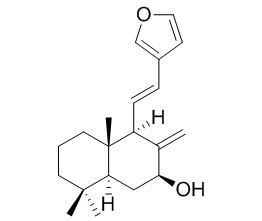Coronarin A
Coronarin, A, B, C, and D are cytotoxic prinicples from the rhizomes of Hedychium coronarium, Zingiberaceae. Coronarin A exhibits good growth inhibition activities on HUVEC proliferation, it effectively suppresses the growth factor induced tube formation of HUVEC at the concentration of 10 microg/mL. Coronarin A has anti-inflammatory activity, it exhibits potent inhibition (IC50 <6.1708g/mL) against fMLP-induced superoxide production and elastase release.
Inquire / Order:
manager@chemfaces.com
Technical Inquiries:
service@chemfaces.com
Tel:
+86-27-84237783
Fax:
+86-27-84254680
Address:
1 Building, No. 83, CheCheng Rd., Wuhan Economic and Technological Development Zone, Wuhan, Hubei 430056, PRC
Providing storage is as stated on the product vial and the vial is kept tightly sealed, the product can be stored for up to
24 months(2-8C).
Wherever possible, you should prepare and use solutions on the same day. However, if you need to make up stock solutions in advance, we recommend that you store the solution as aliquots in tightly sealed vials at -20C. Generally, these will be useable for up to two weeks. Before use, and prior to opening the vial we recommend that you allow your product to equilibrate to room temperature for at least 1 hour.
Need more advice on solubility, usage and handling? Please email to: service@chemfaces.com
The packaging of the product may have turned upside down during transportation, resulting in the natural compounds adhering to the neck or cap of the vial. take the vial out of its packaging and gently shake to let the compounds fall to the bottom of the vial. for liquid products, centrifuge at 200-500 RPM to gather the liquid at the bottom of the vial. try to avoid loss or contamination during handling.
Phytochemistry.2021, 181:112539.
Antioxidants (Basel).2024, 13(3):340.
Hum Exp Toxicol.2017, 36(11):1169-1176
J Ethnopharmacol.2024, 333:118415.
Korean j.of Pharm.2017, 70-76
Appl. Sci.2022, 12(17), 8646.
Korean J. Medicinal Crop Sci.2022, 30(2):117-123.
Appl. Sci.2020, 10(5),1713.
Food Chem X.2024, 24:101909.
Nutrients.2024, 16(19):3266.
Related and Featured Products
Chem Pharm Bull (Tokyo). 2012;60(2):246-50.
Labdane-type diterpenoids from the rhizomes of Hedychium coronarium inhibit lipopolysaccharide-stimulated production of pro-inflammatory cytokines in bone marrow-derived dendritic cells.[Pubmed:
22293485]
The rhizomes of Hedychium coronarium have been used for the treatment of inflammation, skin diseases, headache, and sharp pain due to rheumatism in traditional medicine.
METHODS AND RESULTS:
From this plant, two new labdanes, 15-methoxylabda-8(17),11E,13-trien-16,15-olide (1) and 16-methoxylabda-8(17),11E,13-trien-15,16-olide (3), named hedycoronens A and B, as well as four known, labda-8(17),11,13-trien-16,15-olide (2), 16-hydroxylabda-8(17),11,13-trien-15,16-olide (4), Coronarin A (5), and corronarin E (6) were isolated. Their chemical structures were elucidated by mass, 1D- and 2D-nuclear magnetic resonance (NMR) spectroscopy. They were evaluated for inhibitory effects on the lipopolysaccharide (LPS)-stimulated production of pro-inflammatory cytokines in bone marrow-derived dendritic cells.
CONCLUSIONS:
Among of them, compounds 1-3 were potent inhibitors of LPS-stimulated interleukin-6 (IL-6) and IL-12 p40, with IC(50) ranging from 4.1±0.2 to 9.1±0.3 μM. Compounds 1 and 3 showed moderate inhibitory activity on the tumor necrosis factor-α (TNF-α) production with IC(50) values of 46.0±1.3 and 12.7±0.3 μM. The remains of compounds showed inactivity.
These results warrant further studies concerning the potential anti-inflammatory benefits of labdane-diterpenes from H. coronarium.
Phytother Res. 2010 Jul;24(7):1009-13. doi: 10.1002/ptr.3057.
Labdane-type diterpenes from Hedychium gardnerianum with potent cytotoxicity against human small cell lung cancer cells.[Pubmed:
19960422]
METHODS AND RESULTS:
Seven labdane-type diterpenes, coronarin E, Coronarin A, yunnanCoronarin A, yunnancoronarin B, hedyforrestin B, villosin, and hedyforrestin C were isolated from the rhizome of Hedychium gardnerianum and evaluated for cytotoxic activity against human small cell lung cancer (NCI-H187) and non-cancerous Vero cells. The results showed that villosin exhibited potent cytotoxic activity with IC(50) of 0.40 microM, which was higher than that of the drug ellipticine (IC(50) 1.79 microM). Moreover, ellipticine was very toxic to Vero cells (IC(50) 7.47 microM) whereas the toxicity of villosin was undetectable at concentration lower than 166.42 microM.
CONCLUSIONS:
The results have indicated that the lactone ring is essential for high cytotoxic activity and that the presence of a hydroxyl group at the 6 or 7 position causes decrease in activity. The very high cytotoxicity against the NCI-H187 cells and the exceptionally high selectivity index (>416) of villosin suggested that this compound may be used as a potential lead molecule for antitumor therapeutic development.
Planta Med., 2011, 77(12):1344-1344.
New labdane-type diterpenoids and anti-inflammatory constituents from the rhizome of Hedychium coronarium[Reference:
WebLink]
METHODS AND RESULTS:
Hedychium coronarium J.Koenig (Zingiberaceae) is a terrestrial epiphytic herb, which is distribution in India, Malaysia, Vietnam, southern China and Taiwan [1]. Two new labdane-type diterpenoids, hedychicoronarin (1) and peroxycoronarin D (2), together with eleven known compounds, including calcaratarin (3), (+)-Coronarin A (4), coronarin D (5), coronarin D methyl ether (6), (E)-labda-8(17),12-diene-15,16-dial (7), ergosta-4,6,8(14),22-tetraen-3-one (8), β-sitostenone (9), stigmasta-4,22-dien-3-one (10), oleic acid (11), stearic acid (12), and palmitic acid (13) have been isolated from the rhizomes of Hedychium coronarium. The structure of new compounds 1 and 2 was determined through spectral analyses including extensive 2D NMR data.
CONCLUSIONS:
Among the isolates, calcaratarin (3), Coronarin A (4), (E)-labda-8(17),12-diene-15,16-dial (7), and oleic acid (11) exhibited potent inhibition (IC50 <6.17μg/mL) against fMLP-induced superoxide production and elastase release.
Planta Med., 1988, 54(54):311-5.
Cytotoxic Diterpenes from the Rhizomes of Hedychium coronarium[Reference:
WebLink]
METHODS AND RESULTS:
Four new labdane-type diterpenes, Coronarin A, CoronarinB, Coronarin C, and Coronarin D, and one known labdane-type diterpene, (E)-labda-8(17), 12- diene-15, 16-dial were isolated as cytotoxic prinicples from the rhizomes of Hedychium coronarium, Zingiberaceae. The structures were established by chemical and spectroscopic methods.
Bioorg Med Chem Lett. 2003 Jun 16;13(12):2009-12.
A study on the synthesis of antiangiogenic (+)-coronarin A and congeners from (+)-sclareolide.[Pubmed:
12781184]
METHODS AND RESULTS:
Coronarin A 1, epi-Coronarin A 2 and some synthetic intermediates 14a and 14b synthesized from sclareolide exhibit good growth inhibition activities on HUVEC proliferation. In particular, Coronarin A 1 and epi-Coronarin A 2 effectively suppressed the growth factor induced tube formation of HUVEC at the concentration of 10 micro g/mL.



